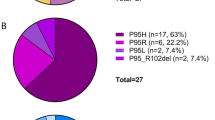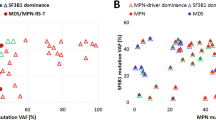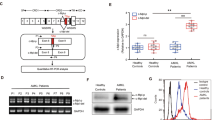Abstract
Signal transducer and activator of transcription (STAT) proteins are phosphorylated and activated by Janus kinases (JAKs). Recently, several groups identified a recurrent somatic point mutation constitutively activating the hematopoietic growth factor receptor-associated JAK2 tyrosine kinase in diverse chronic myeloid disorders – most commonly classic myeloproliferative disorders (MPD), especially polycythemia vera. We hypothesized that the JAK2 V617F mutation might also be present in samples from patients with acute myeloid leukemia (AML), especially erythroleukemia (AML-M6) or megakaryoblastic leukemia (AML-M7), where it might mimic erythropoietin or thrombopoietin signaling. First, we documented STAT3 activation by immunoblotting in AML-M6 and other AML subtypes. Immunoperoxidase staining confirmed phosphorylated STAT3 in malignant myeloblasts (21% of cases, including all AML-M3 samples tested). We then analyzed genomic DNA from 162 AML, 30 B-cell lymphoma, and 10 chronic lymphocytic leukemia (CLL) samples for JAK2 mutations, and assayed a subset for SOCS1 and FLT3 mutations. Janus kinase2 V617F was present in 13/162 AML samples (8%): 10/13 transformed MPD, and three apparent de novo AML (one of 12 AML-M6, one of 24 AML-M7, and one AML-M2 – all mixed clonality). FLT3 mutations were present in 5/32 (16%), while SOCS1 mutations were totally absent. Lymphoproliferative disorder samples were both JAK2 and SOCS1 wild type. Thus, while JAK2 V617F is uncommon in de novo AML and probably does not occur in lymphoid malignancy, unexplained STAT3 activation is common in AML. Janus kinase2 extrinsic regulators and other proteins in the JAK-STAT pathway should be interrogated to explain frequent STAT activation in AML.
This is a preview of subscription content, access via your institution
Access options
Subscribe to this journal
Receive 12 print issues and online access
$259.00 per year
only $21.58 per issue
Buy this article
- Purchase on Springer Link
- Instant access to full article PDF
Prices may be subject to local taxes which are calculated during checkout


Similar content being viewed by others
References
Yamaoka K, Saharinen P, Pesu M, Holt III VE, Silvennoinen O, O'Shea JJ . The Janus kinases (Jaks). Genome Biol 2004; 5: 253.
Yu H, Jove R . The STATs of cancer – new molecular targets come of age. Nat Rev Cancer 2004; 4: 97–105.
Schindler CW . Series introduction. JAK-STAT signaling in human disease. J Clin Invest 2002; 109: 1133–1137.
Spiekermann K, Biethahn S, Wilde S, Hiddemann W, Alves F . Constitutive activation of STAT transcription factors in acute myelogenous leukemia. Eur J Haematol 2001; 67: 63–71.
Spiekermann K, Bagrintseva K, Schwab R, Schmieja K, Hiddemann W . Overexpression and constitutive activation of FLT3 induces STAT5 activation in primary acute myeloid leukemia blast cells. Clin Cancer Res 2003; 9: 2140–2150.
Spiekermann K, Pau M, Schwab R, Schmieja K, Franzrahe S, Hiddemann W . Constitutive activation of STAT3 and STAT5 is induced by leukemic fusion proteins with protein tyrosine kinase activity and is sufficient for transformation of hematopoietic precursor cells. Exp Hematol 2002; 30: 262–271.
Benekli M, Xia Z, Donohue KA, Ford LA, Pixley LA, Baer MR et al. Constitutive activity of signal transducer and activator of transcription 3 protein in acute myeloid leukemia blasts is associated with short disease-free survival. Blood 2002; 99: 252–257.
Gouilleux-Gruart V, Debierre-Grockiego F, Gouilleux F, Capiod JC, Claisse JF, Delobel J et al. Activated Stat related transcription factors in acute leukemia. Leuk Lymphoma 1997; 28: 83–88.
Kirito K, Nagashima T, Ozawa K, Komatsu N . Constitutive activation of Stat1 and Stat3 in primary erythroleukemia cells. Int J Hematol 2002; 75: 51–54.
Schuringa JJ, Wierenga AT, Kruijer W, Vellenga E . Constitutive Stat3, Tyr705, and Ser727 phosphorylation in acute myeloid leukemia cells caused by the autocrine secretion of interleukin-6. Blood 2000; 95: 3765–3770.
Gouilleux-Gruart V, Gouilleux F, Desaint C, Claisse JF, Capiod JC, Delobel J et al. STAT-related transcription factors are constitutively activated in peripheral blood cells from acute leukemia patients. Blood 1996; 87: 1692–1697.
Minami M, Inoue M, Wei S, Takeda K, Matsumoto M, Kishimoto T et al. STAT3 activation is a critical step in gp130-mediated terminal differentiation and growth arrest of a myeloid cell line. Proc Natl Acad Sci USA 1996; 93: 3963–3966.
Nakajima K, Yamanaka Y, Nakae K, Kojima H, Ichiba M, Kiuchi N et al. A central role for Stat3 in IL-6-induced regulation of growth and differentiation in M1 leukemia cells. EMBO J 1996; 15: 3651–3658.
Ning ZQ, Li J, Arceci RJ . Signal transducer and activator of transcription 3 activation is required for Asp(816) mutant c-Kit-mediated cytokine-independent survival and proliferation in human leukemia cells. Blood 2001; 97: 3559–3567.
Baxter EJ, Scott LM, Campbell PJ, East C, Fourouclas N, Swanton S et al. Acquired mutation of the tyrosine kinase JAK2 in human myeloproliferative disorders. Lancet 2005; 365: 1054–1061.
Levine RL, Wadleigh M, Cools J, Ebert BL, Wernig G, Huntly BJP et al. Activating mutation in the tyrosine kinase JAK2 in polycythemia vera, essential thrombocythemia, and myeloid metaplasia with myelofibrosis. Cancer Cell 2005; 7: 387–397.
James C, Ugo V, Le Couedic J-P, Staerk J, Delhommeau F, Lacout C et al. A unique clonal JAK2 mutation leading to constitutive signalling causes polycythaemia vera. Nature 2005; 434: 1144–1148.
Kralovics R, Passamonti F, Buser AS, Teo S-S, Tiedt R, Passweg JR et al. A gain-of-function mutation of JAK2 in myeloproliferative disorders. N Engl J Med 2005; 352: 1779–1790.
Zhao R, Xing S, Li Z, Fu X, Li Q, Krantz SB et al. Identification of an acquired JAK2 mutation in Polycythemia vera. J Biol Chem 2005; 280: 22788–22792.
Nelson ME, Steensma DP . JAK2 V617F in myeloid disorders: What do we know now, and where are we headed? Leuk Lymphoma 2006; 47: 177–194.
Jones AV, Kreil S, Zoi K, Waghorn K, Curtis C, Zhang L et al. Widespread occurrence of the JAK2 V617F mutation in chronic myeloproliferative disorders. Blood 2005; 106: 2162–2168.
Steensma DP, Dewald GW, Lasho TL, Powell HL, McClure RF, Levine RL et al. The JAK2 V617F activating tyrosine kinase mutation is an infrequent event in both ‘atypical’ myeloproliferative disorders and myelodysplastic syndromes. Blood 2005; 106: 1207–1209.
Vainchenker W, Constantinescu SN . A unique activating mutation in JAK2 (V617F) is at the origin of polycythemia vera and allows a new classification of myeloproliferative diseases. Hematology (Am Soc Hematol Educ Program) 2005, 195–200.
Tefferi A, Gilliland DG . The JAK2V617F tyrosine kinase mutation in myeloproliferative disorders: status report and immediate implications for disease classification and diagnosis. Mayo Clin Proc 2005; 80: 947–958.
Tefferi A, Gilliland DG . JAK2 in myeloproliferative disorders is not just another kinase. Cell Cycle 2005; 4: 1053–1056.
Harrison CN . Essential thrombocythaemia: challenges and evidence-based management. Br J Haematol 2005; 130: 153–165.
Kaushansky K . On the molecular origins of the chronic myeloproliferative disorders: it all makes sense. Blood 2005; 105: 4187–4190.
James C, Ugo V, Casadevall N, Constantinescu SN, Vainchenker W . A JAK2 mutation in myeloproliferative disorders: pathogenesis and therapeutic and scientific prospects. Trends Mol Med 2005; 11: 546–554.
Sandberg EM, Wallace TA, Godeny MD, VonDerLinden D, Sayeski PP . Jak2 tyrosine kinase: a true Jak of all trades? Cell Biochemistry and Biophysics 2004; 41: 207–232.
Bennett JM, Catovsky D, Daniel MT, Flandrin G, Galton DA, Gralnick HR et al. Proposals for the classification of the acute leukaemias. French-American-British (FAB) co-operative group. Br J Haematol 1976; 33: 451–458.
Harris NL, Jaffe ES, Diebold J, Flandrin G, Muller-Hermelink HK, Vardiman J et al. The World Health Organization classification of neoplastic diseases of the hematopoietic and lymphoid tissues. Report of the Clinical Advisory Committee meeting, Airlie House, Virginia, November, 1997. Ann Oncol 1999; 10: 1419–1432.
Kaufmann SH . Reutilization of immunoblots after chemiluminescent detection. Anal Biochem 2001; 296: 283–286.
Novak U, Harpur AG, Paradiso L, Kanagasundaram V, Jaworowski A, Wilks AF et al. Colony-stimulating factor 1-induced STAT1 and STAT3 activation is accompanied by phosphorylation of Tyk2 in macrophages and Tyk2 and JAK1 in fibroblasts. Blood 1995; 86: 2948–2956.
Gilliland DG, Griffin JD . The roles of FLT3 in hematopoiesis and leukemia. Blood 2002; 100: 1532–1542.
Sohal J, Phan VT, Chan PV, Davis EM, Patel B, Kelly LM et al. A model of APL with FLT3 mutation is responsive to retinoic acid and a receptor tyrosine kinase inhibitor, SU11657. Blood 2003; 101: 3188–3197.
Boultwood J, Wainscoat JS . Clonality in the myelodysplastic syndromes. Int J Hematol 2001; 73: 411–415.
Jelinek J, Oki Y, Gharibyan V, Bueso-Ramos C, Prchal JT, Verstovsek S et al. JAK2 mutation 1849G>T is rare in acute leukemias but can be found in CMML, Philadelphia chromosome-negative CML, and megakaryocytic leukemia. Blood 2005; 106: 3370–3373.
Levine RL, Loriaux M, Huntly BJ, Loh ML, Beran M, Stoffregen E et al. The JAK2V617F activating mutation occurs in chronic myelomonocytic leukemia and acute myeloid leukemia, but not in acute lymphoblastic leukemia or chronic lymphocytic leukemia. Blood 2005; 106: 3377–3379.
Scott LM, Campbell PJ, Baxter EJ, Todd T, Stephens P, Edkins S et al. The V617F JAK2 mutation is uncommon in cancers and in myeloid malignancies other than the classic myeloproliferative disorders. Blood 2005; 106: 2920–2921.
Lee JW, Kim YG, Soung YH, Han KJ, Kim SY, Rhim HS et al. The JAK2 V617F mutation in de novo acute myelogenous leukemias. Oncogene 2005: [E-pub October 10, 2005].
Huang MJ, Li CY, Nichols WL, Young JH, Katzmann JA . Acute leukemia with megakaryocytic differentiation: a study of 12 cases identified immunocytochemically. Blood 1984; 64: 427–439.
Amin MB, Maeda K, Carey JL, Babu RV, Raman BK . Megakaryoblastic termination of myeloproliferative disorders. Henry Ford Hosp Med J 1992; 40: 122–126.
Kurashima K, Kawamura Y, Ohka T, Hayashi M, Matsuda T . Primary myelofibrosis terminating in megakaryoblastic crisis. Jpn J Med 1990; 29: 226–229.
Akahoshi M, Oshimi K, Mizoguchi H, Okada M, Enomoto Y, Watanabe Y . Myeloproliferative disorders terminating in acute megakaryoblastic leukemia with chromosome 3q26 abnormality. Cancer 1987; 60: 2654–2661.
Takahashi M, Koike T, Nagayama R, Fujiwara M, Koyama S, Ohnishi M et al. Myelodysplastic syndrome with myelofibrosis: myelodysplastic syndrome as a major primary disorder for acute myelofibrosis. Clin Lab Haematol 1991; 13: 17–23.
Manoharan A, Islam A . Acute megakaryoblastic leukaemia or acute myelofibrosis? Br J Haematol 1979; 43: 157–158.
Orazi A, O'Malley DP, Jiang J, Vance GH, Thomas J, Czader M et al. Acute panmyelosis with myelofibrosis: an entity distinct from acute megakaryoblastic leukemia. Mod Pathol 2005; 18: 603–614.
Thiele J, Kvasnicka HM, Zerhusen G, Vardiman J, Diehl V, Luebbert M et al. Acute panmyelosis with myelofibrosis: a clinicopathological study on 46 patients including histochemistry of bone marrow biopsies and follow-up. Ann Hematol 2004; 83: 513–521.
Steensma DP, Hanson CA, Letendre L, Tefferi A . Myelodysplasia with fibrosis: a distinct entity? Leuk Res 2001; 25: 829–838.
Thiede C, Steudel C, Mohr B, Schaich M, Schakel U, Platzbecker U et al. Analysis of FLT3-activating mutations in 979 patients with acute myelogenous leukemia: association with FAB subtypes and identification of subgroups with poor prognosis. Blood 2002; 99: 4326–4335.
Abu-Duhier FM, Goodeve AC, Wilson GA, Gari MA, Peake IR, Rees DC et al. FLT3 internal tandem duplication mutations in adult acute myeloid leukaemia define a high-risk group. Br J Haematol 2000; 111: 190–195.
Muller-Tidow C, Steur C, Mizuki M, Schwable J, Brandts C, Berdel WE et al. Mutationen des Wachstumsfaktor-Rezeptors Flt3 bei Akuter Myeloischer Leukamie – Transformation myeloischer Zellen durch Ras-abhangige und Ras-unabhangige Mechanismen. Deutsche Medizinische Wochenschrift 2002; 127: 2195–2200.
Kawasaki A, Matsumura I, Kataoka Y, Takigawa E, Nakajima K, Kanakura Y . Opposing effects of PML and PML/RAR alpha on STAT3 activity. Blood 2003; 101: 3668–3673.
Melzner I, Bucur AJ, Bruderlein S, Dorsch K, Hasel C, Barth TF et al. Biallelic mutation of SOCS-1 impairs JAK2 degradation and sustains phospho-JAK2 action in the MedB-1 mediastinal lymphoma line. Blood 2005; 105: 2535–2542.
Galm O, Yoshikawa H, Esteller M, Osieka R, Herman JG . SOCS-1, a negative regulator of cytokine signaling, is frequently silenced by methylation in multiple myeloma. Blood 2003; 101: 2784–2788.
Mestre C, Rubio-Moscardo F, Rosenwald A, Climent J, Dyer MJ, Staudt L et al. Homozygous deletion of SOCS1 in primary mediastinal B-cell lymphoma detected by CGH to BAC microarrays. Leukemia 2005; 19: 1082–1084.
Walrafen P, Verdier F, Kadri Z, Chretien S, Lacombe C, Mayeux P . Both proteasomes and lysosomes degrade the activated erythropoietin receptor. Blood 2005; 105: 600–608.
Verdier F, Walrafen P, Hubert N, Chretien S, Gisselbrecht S, Lacombe C et al. Proteasomes regulate the duration of erythropoietin receptor activation by controlling down-regulation of cell surface receptors. J Biol Chem 2000; 275: 18375–18381.
Montoye T, Lemmens I, Catteeuw D, Eyckerman S, Tavernier J . A systematic scan of interactions with tyrosine motifs in the erythropoietin receptor using a mammalian 2-hybrid approach. Blood 2005; 105: 4264–4271.
Tsui HW, Siminovitch KA, de Souza L, Tsui FW . Motheaten and viable motheaten mice have mutations in the haematopoietic cell phosphatase gene. Nat Genet 1993; 4: 124–129.
Niwa Y, Kanda H, Shikauchi Y, Saiura A, Matsubara K, Kitagawa T et al. Methylation silencing of SOCS-3 promotes cell growth and migration by enhancing JAK/STAT and FAK signalings in human hepatocellular carcinoma. Oncogene 2005: [E-pub June 27, 2005].
Esteller M . Profiling aberrant DNA methylation in hematologic neoplasms: a view from the tip of the iceberg. Clin Immunol 2003; 109: 80–88.
Oshimo Y, Kuraoka K, Nakayama H, Kitadai Y, Yoshida K, Chayama K et al. Epigenetic inactivation of SOCS-1 by CpG island hypermethylation in human gastric carcinoma. Int J Cancer 2004; 112: 1003–1009.
Acknowledgements
We thank Nga T Dai and David A Loegering for assistance with immunoblotting. This project was funded by National Cancer Institute grants K12 CA90628 to DPS, R01 CA69008 to SHK, and P50 CA97274 (Mayo Clinic/University of Iowa Lymphoma Specialized Program of Research Excellence), and by a grant from the Robert A Kyle Hematological Malignancies Program to DPS. The authors have no potential conflicts of intrest to report.
Author information
Authors and Affiliations
Corresponding author
Additional information
Supplementary Information accompanies the paper on the Leukemia website (http://www.nature.com/leu)
Supplementary information
Rights and permissions
About this article
Cite this article
Steensma, D., McClure, R., Karp, J. et al. JAK2 V617F is a rare finding in de novo acute myeloid leukemia, but STAT3 activation is common and remains unexplained. Leukemia 20, 971–978 (2006). https://doi.org/10.1038/sj.leu.2404206
Received:
Revised:
Accepted:
Published:
Issue Date:
DOI: https://doi.org/10.1038/sj.leu.2404206
Keywords
This article is cited by
-
De Novo JAK2 V617 F Positive AML: The Picture is Getting Clearer
Indian Journal of Hematology and Blood Transfusion (2019)
-
ALOX5 exhibits anti-tumor and drug-sensitizing effects in MLL-rearranged leukemia
Scientific Reports (2017)
-
‘Acute myeloid leukemia: a comprehensive review and 2016 update’
Blood Cancer Journal (2016)
-
New insights into the Shwachman-Diamond Syndrome-related haematological disorder: hyper-activation of mTOR and STAT3 in leukocytes
Scientific Reports (2016)
-
The aurora kinases in cell cycle and leukemia
Oncogene (2015)



